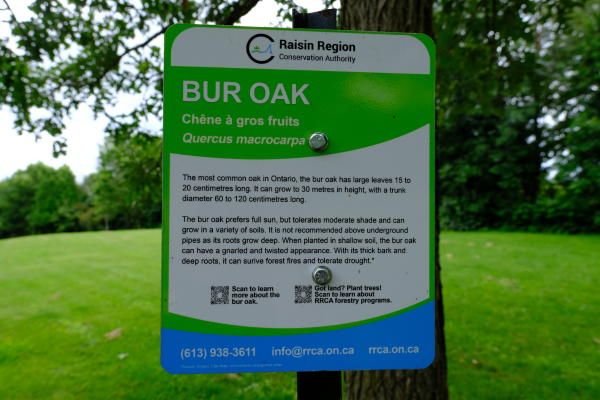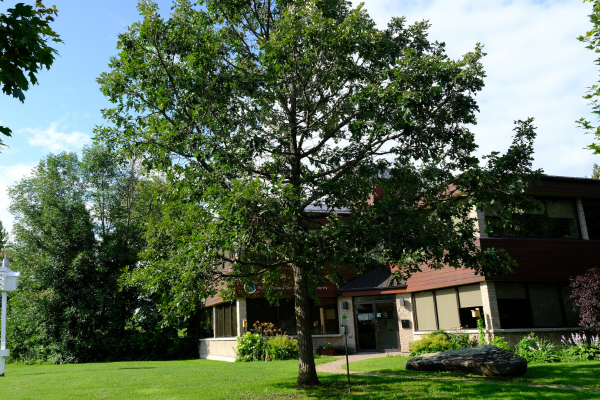Scientific name: Quercus macrocarpa
Quercus = Comes from the classical Latin name for oak trees.
macrocarpa = Combination of the Greek words macro meaning “large” and karpos meaning “fruit” referring to the large fruits (acorns) that the tree produces.
Bur oak is the most common oak species in Ontario, found all throughout. Similar in appearance to white oak, bur oak can be differentiated by its leaves, which have shallower and more rounded lobes. This tree has very thick, corky bark and deep-growing roots, making it very drought and fire resistant, which contributed to its large population. Wildlife like deer, squirrels, and birds love their sweet acorns. These acorns have a deep cup with a bristly fringe of overlapping pointy scales around the edge.
Bur Oak can tolerate a wide variety of soil types and moisture levels. While they can tolerate moderate shade, they prefer full sun. Depending on the location, bur oak can grow in different shapes. While it is usually tall with a straight trunk, when grown in shallow soil, it will be smaller, with a twisted trunk and gnarled branches. Bur oak is a popular choice as an ornamental due to its resistance to insect and fungal diseases, droughts, and air pollution. The tree should not be planted near any underground pipes, which can be damaged by its wide spreading roots.
The wood from bur oak is very durable and is used for flooring, boats and canoes, watertight barrels, cabinets, and furniture. The edible acorns are traditionally and currently used as a food source, often being ground into flour, and used in baked goods like bread. To see how to turn acorns into flour, check out "How to make FLOUR from ACORNS."
The signs and tags at the Edible Forest are in place for educational purposes and should not necessarily be used for identification. Visitors may identify, consume, forage, and prepare plants from the Edible Forest at their own risk. Visitors should be aware that ingesting toxic or poisonous plants could lead to life-threating injuries or allergic reactions. In the event of an emergency, call 911.
Sources:
OMNR, 2022. Ontario Ministry of Natural Resources: Ontario Tree Atlas. [online] Available: https://www.ontario.ca/page/bur-oak
OMNR. Ontario's Tree Atlas. [online] Available: https://pecmastergardeners.ca/wp-content/uploads/2020/07/Ontarios-Tree-Atlas.pdf
Petruzzello, M. 2021. bur oak. The Encyclopedia Britannica. [online] Available: https://www.britannica.com/plant/bur-oak
Stoner, N. Bur Oak. Nebraska Horniculture, Landscape, and Environmental Systems. [online] Available: https://hles.unl.edu/bur-oak
University of Guelph. Guelph Arboretum: Bur oak - Quercus macrocarpa. [online] Available: https://arboretum.uoguelph.ca/thingstosee/trees/buroak
%20938-3611%20info%40rrca_on_ca%20rrca_on_catrees%20(400%20%C3%97%20200%20px)%20(1).jpg)


 Bur oak is sometimes called the mossy-cup oak due to the heavily fringed acorn cups the tree produces.
Bur oak is sometimes called the mossy-cup oak due to the heavily fringed acorn cups the tree produces.  Bur oaks are medium to large trees, reaching up to 30 meters tall. Their trunks can reach 1.2 meters in diameter.
Bur oaks are medium to large trees, reaching up to 30 meters tall. Their trunks can reach 1.2 meters in diameter..png) Leaves are large (15 to 25 centimeters in length), shiny green on top and pale and hairy beneath.
Leaves are large (15 to 25 centimeters in length), shiny green on top and pale and hairy beneath..png)